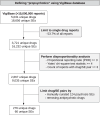Pharmacologic and genetic evidence converge on mechanisms of psychotic illness
- PMID: 40701976
- PMCID: PMC12287348
- DOI: 10.1038/s41398-025-03456-7
Pharmacologic and genetic evidence converge on mechanisms of psychotic illness
Abstract
Idiopathic and substance-induced forms of psychotic illness afflict millions of people worldwide, and it is largely unknown whether these two forms emerge through the same molecular mechanisms. Though genetic studies have implicated thousands of genes in idiopathic psychotic illnesses (e.g., schizophrenia), consensus is lacking regarding which of these genes are most likely to treat psychotic illness when modulated pharmacologically and, as a result, antipsychotic medications targeting these genes have yet to be developed. Previous studies suggest that one way to determine if a candidate target gene is likely to lead to an effective treatment for a given illness is if the gene is implicated by multiple lines of evidence (e.g., genetic, pharmacologic). Here, pharmacologic, genetic, and clinical data were leveraged to determine if the idiopathic and substance-induced forms of psychotic illness are related to one another through a common set of genes. A set of medications that cause psychotic illness as a side effect ("propsychotics") were identified by analyzing 15 million medication side effects reports from over 100 countries. Gene products targeted by propsychotics overlapped significantly with those targeted by antipsychotics and for many of the overlapping targets propsychotics act through a mechanism that was qualitatively the opposite of the mechanism through which antipsychotics act (e.g., activation vs. inhibition). Propsychotic and antipsychotic target genes were significantly enriched for genes implicated in schizophrenia by rare loss-of-function genetic variation but not for genes implicated in schizophrenia by common genetic variation. Only one gene - GRIN2A, encoding the GluN2A subunit of the NMDA glutamate receptor - was implicated in psychotic illness by propsychotics, rare loss-of-function genetic variation, and common genetic variation. Mining genetic data from a diverse cohort of 30,000 adults treated in a New York City health system, a carrier of a rare loss-of-function variant in GRIN2A with severe psychotic illness was identified with a clinical course notable for psychotic symptoms and cognitive deficits that are not targeted by current antipsychotics. Altogether, this report shows how integrating pharmacologic, genetic, and clinical data from large cohorts can prioritize target genes for novel drug development and align the prioritized targets with specific clinical presentations.
© 2025. The Author(s).
Conflict of interest statement
Competing interests: The authors declare no competing interests. Ethics approval and consent to participate: All methods were performed in accordance with the relevant guidelines and regulations. Relevant study activities for the current report were approved by the Icahn School of Medicine at Mount Sinai Institutional Review Board (Institutional Review Board 07 0529). Our study utilizes data from large, publicly available or institutional databases that do not contain identifiable patient-level data, and as such, informed consent from individual participants was not required.
Figures




References
-
- Association AP. Diagnostic and statistical manual of mental disorders, (DSM-5®). Washington, D.C., American Psychiatric Pub; 2013.
-
- Carpenter WT Jr., Kirkpatrick B. The heterogeneity of the long-term course of schizophrenia. Schizophr Bull. 1988;14:645–52. - PubMed
-
- McCarthy-Jones S, Smailes D, Corvin A, Gill M, Morris DW, Dinan TG, et al. Occurrence and co-occurrence of hallucinations by modality in schizophrenia-spectrum disorders. Psychiatry Res. 2017;252:154–60. - PubMed
-
- World Health O. WHO model list of essential medicines, 20th list (March 2017, amended August 2017). Geneva: World Health Organization; 2017.
MeSH terms
Substances
LinkOut - more resources
Full Text Sources
Medical
Miscellaneous

